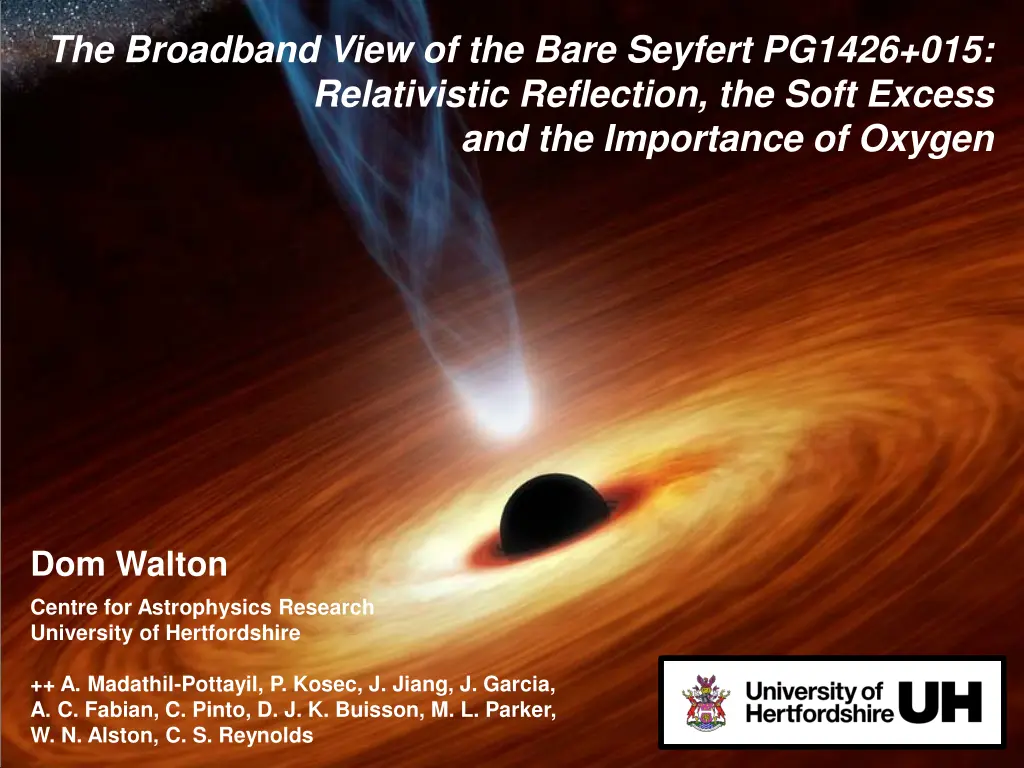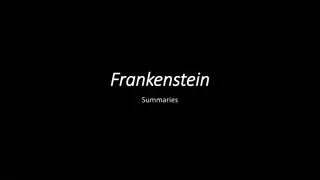
Broadband View of Seyfert PG1426 - Relativistic Reflection
Explore the relativistic reflection, soft excess, and oxygen black holes in the broadband view of the bare Seyfert PG1426+015. Discover insights on the black hole's spin and corona geometry through high-energy emissions and variable density models impacting low-energy emission lines.
Download Presentation

Please find below an Image/Link to download the presentation.
The content on the website is provided AS IS for your information and personal use only. It may not be sold, licensed, or shared on other websites without obtaining consent from the author. If you encounter any issues during the download, it is possible that the publisher has removed the file from their server.
You are allowed to download the files provided on this website for personal or commercial use, subject to the condition that they are used lawfully. All files are the property of their respective owners.
The content on the website is provided AS IS for your information and personal use only. It may not be sold, licensed, or shared on other websites without obtaining consent from the author.
E N D
Presentation Transcript
The Broadband View of the Bare Seyfert PG1426+015: Relativistic Reflection, the Soft Excess and the Importance of Oxygen Black Holes and Accretion: Observational Frontiers Dom Walton Dom Walton Centre for Astrophysics Research University of Hertfordshire NASA Postdoctoral Fellow JPL/Caltech ++ A. Madathil-Pottayil, P. Kosec, J. Jiang, J. Garcia, A. C. Fabian, C. Pinto, D. J. K. Buisson, M. L. Parker, W. N. Alston, C. S. Reynolds
Relativistic Disc Reflection Broad Fe K emission High-energy continuum Relativistic disc reflection carries information regarding both the spin of the black hole and the geometry of the corona 2
The Soft Excess A ~smooth excess of emission seen in unobscured AGN below ~2 keV when the ~2-10 keV powerlaw continuum is extrapolated down in energy Porquet+18 Ark 120 XMM 3
Relativistic Disc Reflection Broad Fe K emission High-energy continuum Soft excess? Relativistic disc reflection carries information regarding both the spin of the black hole and the geometry of the corona 4
Variable Density Models Wealth of low-energy emission lines, all of which will be subject to relativistic blurring Models with densities ?e> 1016 cm 3 also increasingly shift the low-energy free-free emission in the reflection spectrum up into the observed bandpass (> 0.3 keV) Garcia+16 Such densities are predicted by coupled disc-corona models for a wide range of ?BH, ? parameter space (Svensson+94) 1 ? 2 ?e ?BH [for radiation pressure] 5
Variable Density Models Wealth of low-energy emission lines, all of which will be subject to relativistic blurring Models with densities ?e> 1016 cm 3 also increasingly shift the low-energy free-free emission in the reflection spectrum up into the observed bandpass (> 0.3 keV) Garcia+16 Such densities are predicted by coupled disc-corona models for a wide range of ?BH, ? parameter space (Svensson+94) 1 ? 2 ?e ?BH [for radiation pressure] Fabian+00 5
Variable Density Models Wealth of low-energy emission lines, all of which will be subject to relativistic blurring Models with densities ?e> 1016 cm 3 also increasingly shift the low-energy free-free emission in the reflection spectrum up into the observed bandpass (> 0.3 keV) Adapted from Jiang+19 Such densities are predicted by coupled disc-corona models for a wide range of ?BH, ? parameter space (Svensson+94) 1 ? 2 ?e ?BH [for radiation pressure] 5
The Broadband View Mrk509 Ark 120 Porquet+18 Garcia+16a Broadband observations of bare AGN (little/no absorption beyond Galactic ?H) offer the best opportunity to test the relativistic reflection scenario Conflicting reports in the literature over whether relativistic reflection can successfully fit the broadband data in these cases, even in the era of high-density reflection models being available 6
PG1426+015 Walton+25 (subm.) Coordinated XMM+NuSTAR observation of the bare Seyfert PG1426+015 +0.11(Kaspi+00; Peterson+04), so is of Reverb. mapped mas of log ?BH/? = 9.01 0.16 particular interest for efforts to populate the SMBH spin-mass plane (Piotrowska+24) Regardless of the origin of the soft excess, data show clear evidence for reflection from the inner accretion disc via a relativistically broadened iron line + Compton hump 7
PG1426+015 Walton+25 (subm.) Coordinated XMM+NuSTAR observation of the bare Seyfert PG1426+015 +0.11(Kaspi+00; Peterson+04), so is of Reverb. mapped mas of log ?BH/? = 9.01 0.16 particular interest for efforts to populate the SMBH spin-mass plane (Piotrowska+24) Regardless of the origin of the soft excess, data show clear evidence for reflection from the inner accretion disc via a relativistically broadened iron line + Compton hump 7
PG1426+015 Reflection Fits Basic XILLVER-based reflection models fail to reproduce the broadband spectral shape; results in pivoting of the primary continuum to account for soft X-rays at the expense of fitting the highest energies, leaving apparent hard excesses. In contrast, comparable REFLIONX-based reflection models are able to fit the broadband data successfully. 8
The Importance of Oxygen A key difference between the two models is the strength of the OVIII emission at low energies Raw Common smoothing This is much stronger in XILLVER at high densities, and is strong enough to prevent the fits from moving too far into the high-density regime (and thus from bringing in sufficient amounts of free-free emission to fit the soft excess here) Cause of this discrepancy likely down to XILLVER not considering additional line opacity when the line itself becomes optically thick Likely therefore that XILLVER currently overpredicts (some) soft emission lines 9
The Importance of Oxygen A key difference between the two models is the strength of the OVIII emission at low energies This is much stronger in XILLVER at high densities, and is strong enough to prevent the fits from moving too far into the high-density regime (and thus from bringing in sufficient amounts of free-free emission to fit the soft excess here) Cause of this discrepancy likely down to XILLVER not considering additional line opacity when the line itself becomes optically thick Likely therefore that XILLVER currently overpredicts (some) soft emission lines 9
The Importance of Oxygen Reducing the OVIII emission allows the XILLVER-based model to successfully fit the data Also brings the fits into good agreement with the REFLIONX- based models in terms of the disc density; both imply log ?e/cm 3~18 XILLVER-based fit Bkn po emissivity OVIII reduced Such a density is not unreasonable given the combination of ? and ? relevant for PG1426+015 ( ? ~ 0.04 here, giving log ?BH ?2~ 6.2) Broadband models provide preliminary spin constraints: ? ~ 0.77 (REFLIONX) ? ~ 0.95 (XILLVER) 10
In Summary Key Takeaway: Relativistic reflection from the inner accretion disc is able to successfully account for the soft excess in the bare Seyfert PG1426+015, a key testbed for such models In More Detail: In the case of XILLVER-based reflection models, successful fits require a reduction of the OVIII emission at low energies. No such correction is required for successful fits with REFLIONX-based models. There are good reasons to believe such reductions may be reasonable/ necessary for XILLVER (line opacity neglected) When such reductions are allowed, XILLVER- and REFLIONX-based models show good agreement in e.g. the density inferred for the disc (log ?e/cm 3~18 for PG1426+015) OVIII issue likely to be an important consideration when assessing whether relativistic reflection fits in other cases; needs further investigation (more observational work + model development) 11
Supplementary Material
PG1426+015 Density Reducing the OVIII emission allows the XILLVER-based model to successfully fit the data Also brings the fits into good agreement with the REFLIONX- based models in terms of the disc density; both imply log ?e/cm 3~18 Such a density is not unreasonable given the combination of ? and ? relevant for PG1426+015 ( ? ~ 0.04 here, giving log ?BH ?2~ 6.2) Contextual data from: Xu et al. 2021 Wilkins et al. 2022 Madathil-Pottayil et al. 2024 Jiang et al. 2019a,b, 2022 Mallick et al. 2018, 2022 Garcia et al. 2019 Walton et al. 2021
PG1426+015 Spin & Inclination Broadband models provide preliminary spin constraints: ? ~ 0.77 (REFLIONX) ? ~ 0.95 (XILLVER) Formal uncertainties do have some small overlap at the 3? level Hard X-ray data (>2 keV) not yet sufficient to place tight constraints on the spin regardless of the nature of the soft excess (can only say ? 0.15) 99% 95% Constraints here are thus model dependent; some caution needed 90% All fits imply low inclinations of ? 40 , as broadly expected for an unobscured AGN based on the unified model
Main Alternative: Warm Corona Leading alternative is the warm corona Soft excess modelled as a second, cooler, optically-thick corona in addition to the hot corona that produces the hard X-rays Often interpreted as a slab shrouding the inner disc within the framework of a radially-stratified accretion flow; with decreasing radii: Done+12 Standard disc Warm corona Hot corona Typically fits the data well, as the soft excess is a distinct emission component in the X-ray spectrum in this model (e.g. Petrucci+13; Porquet+18) Able to successfully fit the data for PG1426+015 specifically (Mallick+25)
The Soft Excess A ~smooth excess of emission seen in unobscured AGN below ~2 keV when the ~2-10 keV powerlaw continuum is extrapolated down in energy Arnaud+85 Mrk 841 EXOSAT
Suzakusample of bare AGN Walton+13
Historical & Current Explanations Accretion disc emission Essentially debunked Smeared ionised absorption Warm thermal Comptonization Popular today Relativistic reflection
Constant Apparent Temperature Gierlinski+04 Miniutti+09 Constant temperature not expected for blackbody emission (may support atomic origin ), and temperature too hot for typical AGN discs. ACCRETION DISC IS GENERALLY EXCLUDED
Smeared Absorption Ionised absoption could produce a deficit in the ~1-5 keV range Gierlinski+04 If the absorption is velocity broadened (e.g. in a diverging outflow), this could appear as a smooth excess Simulations show the absorption would need outflow velocities of 0.9c to produce the required broadening (Schurch+08) SMEARED ABSORPTION IS GENERALLY EXCLUDED
Relativistic Disc Reflection High-energy continuum Fe K No black hole rotation (a ~ 0) Rapid black hole rotation (a ~ 1) Innermost Stable Circular Orbit (RISCO) BH spin (a)
Ionised Reflection Original idea: in addition to the more prominent Fe K emission, reflection by ionised material produces a complex of low-energy emission lines (lighter elements, Iron L- shell) which are blurred together to produce a ~smooth excess below ~2 keV
Reflection Fits PG 1501+106 XMM, Crummy+06 Fits with a standard reflection-based model to a sample of 25 bare AGN observed with Suzaku, covering ~0.6-30 keV on average (Walton+13):
Typical Results and Implications Results from Walton+13 sample of 25 bare AGN observed with Suzaku: Ionisation parameter typically ~ 200, but broad range exhibited Iron abundance peaks at AFe ~ 1, but some high abundances Reflection fraction peaks at Rdisc ~ 1 (roughly expected for a 2? disc), but some high values Steep emissivity indices (q > 5) often required [emissivity: (r) r q;Newtonian expectation is q ~ 3]
Steep Emissivity Indices Gravitational lightbending (GR) can produce both steep emissivity indices (i.e. q > 3) and reflection-dominated spectra (i.e. Rdisc > 1) h Wilkins+12 Requires the corona to be compact (~a few RG), but this is broadly similar to microlensing results in strongly lensed quasars (see G. Chartas talk) Also suggested that steep emissivities could be related to radial ionisation gradients (which have not typically been treated; Kammoun+19, Ingram+19)
Black Hole Spin Walton+13 Berti+08 Fits also typically imply that most black holes are rapidly rotating, consistent with (coherent) accretion-driven growth scenarios (see also review by Reynolds+19) Reynolds+12 BUT High-spin biases are expected (higher expected radiative efficiencies)
Relativistic Reflection in AGN Risaliti+13, Walton+14 XMM NuSTAR NGC1365 (4 observations, separated in time) Coordinated XMM+NuSTAR observations of NGC1365 all show clear evidence for relativistic disc reflection, with consistent physical parameters: a > 0.95 [Other prominent examples: MCG-6-30-15 (e.g. Marinucci+14a), Mrk335 (e.g. Parker+14), IRAS 13224-3809 (e.g. Jiang+18), Swift J2127.4+5654 (e.g. Marinucci+14b), NGC4151 (e.g. Beuchert+17), NGC3783 (e.g. Brenneman+11), 1H0707-495 (e.g. Fabian+09), etc. etc.]
Iron L-shell Emission 1H0707-495 (Fabian+09) IRAS 13224-3809 (Fabian+13) In some rare cases, strong and relativistically broadened iron L-shell emission (~1 keV) can be seen in addition to and with a similar line profile as the relativistically broadened iron K-shell emission (~6.4 keV) (This is likely related to high iron abundances)
Relativistic Disc Reflection Broad Fe K emission High-energy continuum Soft excess? Relativistic disc reflection carries information regarding both the spin of the black hole and the geometry of the corona
Soft X-ray Reverberation Intrinsic continuum lags (propagation delays?) Reverberation +ve: soft leads hard ve: hard leads soft Soft X-ray reverberation seen for the first time in 1H0707-495 (Fabian+09)!
Soft X-ray Reverberation 1H0707-495 (Kara+13a) IRAS 13224-3809 (Fabian+13) Ark 564 (Kara+13b) High-frequency soft lags are quite common (although there are unusual exceptions), and behave broadly as expected for different BH masses! De Marco+13
Fe K Reverberation MCG-5-23-16 XMM MCG-5-23-16 NuSTAR Fe K reverberation lags have now been seen in a number of cases (also behave as expected), as well as some evidence for reverberation of the Compton hump in a few Zoghbi+13,14 Fe K reverberation lags shows similar amplitudes to soft X-ray reverberation lags Kara+18 Reprocessing occurs in broadly the same region
Low vs High Frequencies Ark 564 (Kara+16)
Hard X-rays and the Soft Excess Fit: 3-79 keV Fit: 0.3-79 keV Ark 120 XMM+NuSTAR Porquet+18 Taking a simultaneous broadband view, combining XMM+NuSTAR, simple relativistic reflection models appear to struggle to reproduce both the soft excess and the high-energy emission in some cases (Ark 120; see also Matt+14)
Hard X-rays and the Soft Excess 1H 1934-063 Mrk509: Garcia+16a Jiang+19a In other cases with simultaneous observations, the reflection model can reproduce the available soft and hard X-ray data
Accretion Disc Density Classic REFLIONX/ XILLVER f fraction of accretion power dissipated in the corona SS73 Garcia+16b, based on disc-corona solutions from Svensson+94
Variable Density Models Results Jiang+19a Variable density models fit to a selection of AGN, combining sources with X-ray data from the reverberation-mapped sample and sources with high Fe abundances Some evidence for anti-correlations seen for ne vs M and M 2
Variable Density Models Results Jiang+19a High-density models help bring Fe abundances down in the most extreme cases Spin estimates generally consistent with those obtained previously (assuming the soft excess is reflection), still typically imply rapidly rotating BHs
Hard X-rays and the Soft Excess Simulations suggest we should expect a statistical correlation between soft excess strength and reflection fraction (Vasudevan+14)
Hard X-rays and the Soft Excess Vasudevan+14 Boissay+16 Combining XMM and Swift-BAT, Vasudevan+14 find weak evidence for a positive correlation, but Boissay+16 find evidence for an anti-correlation (!) Something of an open issue
Hard X-rays and the Soft Excess Ark 120 XMM+NuSTAR Matt+14 Taking a simultaneous broadband view, combining XMM+NuSTAR, simple relativistic reflection models appear to struggle to reproduce both the soft excess and the high-energy emission in some cases (Ark 120; see also Porquet+18)






















